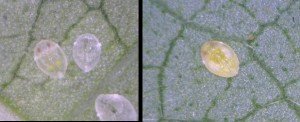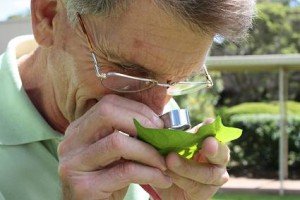We have fielded numerous enquiries this week from consultants who would like to assess levels of whitefly parasitism. This is achievable in the field with the use of a hand lens.
Parasitism levels appear to be a little down from last year, but still good levels have been recovered. Parasitism so far has ranged from 50-90% in Emerald, 35% in St George, 20% on the Downs and 10% in lower Namoi.
Whitefly parasitoids are small wasps. There are two parasitoids that are commonly encountered in cotton, Eretmocerus and Encarsia. Eretmocerus hayati was released for biological control of whitefly in cotton and horticulture and is the most effective and abundant parasitoid in the cotton system.
The parasitoid wasps attack early instar whitefly nymphs. The female wasp is capable of laying hundreds of eggs which she deposits individually underneath the nymphs. When the parasitoid larvae hatches, it tunnels into the whitefly and eats it from the inside–out.
Identification of Parasitised Whitefly
Unparasitised whitefly nymph
• Early juvenile stages will be clear with two red eyes and two bright yellow organs (mycetomes) at the tail end (fig. 1).
• As the nymph reaches late 4th instar it will change from clear to a bright yellow with white spots appearing as the wings form (fig. 2).
• The exuviae (or spent pupal case) will be a transparent white (fig. 1).
Figure 1. (left) Early 4th instar whitefly nymph and two exuviae (spent pupal cases).
Figure 2. (right) Late 4th instar whitefly nymph.
Parastised whitefly nymph
• Nymphs are dull or dirty yellow/brown – Eretmocerus parastioid (fig. 3)
or
• Nymphs are dark brown or black – Encarsia parastioid (fig. 4)
• Sometimes the dark semi-circle of the developing parastoid larvae is visible (fig.5).
• Myecetomes appear non-symetrical or irregular.
• Exuviae is ‘dirty’ in appearance.
• Exuviae has a round exit hole where the wasp parasitoid has chewed its way free of the dead whitefly.
Figure 3. (left) Whitefly parasitised with Eretmocerus sp.
Figure 4. (centre) Whitefly parastised with Encarsia sp.
Figure 5. (right) Larvae of developing parasitoid visible inside whitefly nymph.
Correct use of a hand lens
A common complaint for why consultants do not check for parasitism or species composition in whitefly is that the whitefly are ‘too small’. Correct use of a hand lens will make it possible to identify species composition and parasitism.
The correct way to use a hand lens is to hold the hand lens right up to your eye, as close as your sunglasses would be (fig. 6). Then, bring the object into focus by moving the object, not the hand lens.
Often, users hold the hand lens away from their face which gives far less magnification making identification of parasitised whitefly impossible.
Figure 6. Correct use of a hand lens requires users to hold the hand lens very close to their eyes to get the most magnification from the hand lens.
Article and images by Zara Ludgate



